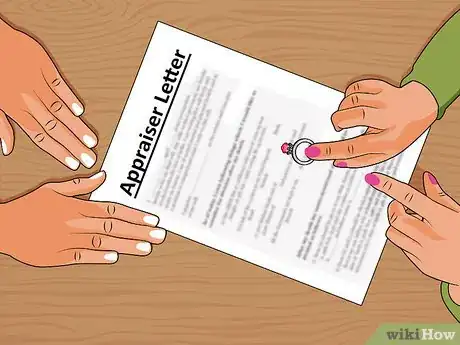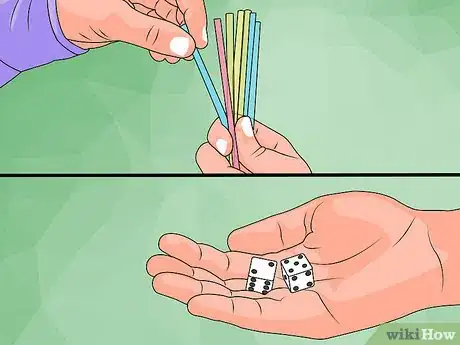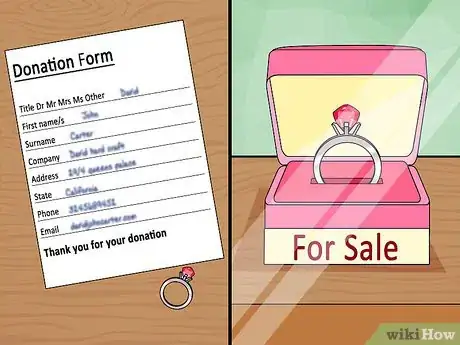This article was co-authored by wikiHow Staff. Our trained team of editors and researchers validate articles for accuracy and comprehensiveness. wikiHow's Content Management Team carefully monitors the work from our editorial staff to ensure that each article is backed by trusted research and meets our high quality standards.
There are 12 references cited in this article, which can be found at the bottom of the page.
This article has been viewed 39,798 times.
Learn more...
Dividing family heirlooms can be a stressful experience. Whether this process is started before or after a loved one’s passing there is no guaranteed stress free method. Family members become emotional, sentimental attachments to objects arise and before you know it a fight can break out over who gets mom’s coffee mug. However, with a positive mindset and an openness to compromise, there are ways to help ensure everyone feels like they’re gaining, and not losing, memories.
Steps
Planning Before Death
-
1Make a will. The best decision you can make when dividing heirlooms is to make a will. While this can be difficult, as it forces all involved to consider your mortality, it can be very beneficial and will ease familial responsibilities after your passing. Invite all children or siblings you will be including in your will together for a family meeting.
-
2Have an open discussion. Express your wishes, but consider family desires. Go through each room and let each family member have the opportunity to discuss the heirlooms. There might be a necklace that holds very little financial value but one sibling has a strong attachment to it because she wore it on her first date. Or maybe your brother has an open spot in his house that would make a great display for the china plate collection.[1] This should be a positive time to share happy memories together as a family!Advertisement
-
3Record everything. Once it is settled who will receive an item be sure to write down the decision. Then when you write up your will be very specific about items. For example don’t write “John gets the china” add details, “John gets the complete Lenox Christmas edition china set, including the candlesticks.” This is not a guarantee that there won’t be any arguments later, but will at least remove any doubt over the person’s wishes.[2]
-
4Compensate financially. Consider the financial distribution of your heirlooms. If a child feels “shorted” is likely to be a source of tension and resentment among the family. An easy way to make things more equal is through the estate sale. For instance, if you want to divide $10,000 worth of jewelry and china among your daughters, but don’t have any comparable items for your sons, then your sons will receive $10,000 more from the estate sale.
-
5Appoint an executor of your will.[3] After you pass you will need someone to make sure your wishes are carried out. This can either be a family member, or a third party. Consider your family dynamics in making this decision. If you know it will cause disharmony to choose one child over another then consider using a third party, a family friend or hiring an attorney.
-
6Start early. Once you’ve discussed everyone’s wishes start giving heirlooms away! It’s better to start the process while all family members are still living. This limits the potential arguments among family after the death and takes added stress off of the family. Additionally, distributing while you’re still alive provides you with the chance to see the joy your family experiences in their new heirlooms.
Planning After Death
-
1Allow family time to grieve. Even if there is a clear will and not much to work out after a death, recognize that your family has still lost an important member. Don’t try to rush through the process. Give yourself and your family time to grieve and support each other through this loss.
-
2Get the items appraised. You may already know if there is an antique or collectible item in the house. However, even if you know your mom’s china cabinet has plates from the 18th century, you may not know its value. There are many options to have items appraised, so it is important to do a little research before making decisions.[4] After you have a list of the items and their values divide the total among the family members involved.
- Professional appraisers. There are certified professionals to appraise almost any item, the Appraisers Association of America[5] and the International Society of Appraisers[6] are two respected organizations look into. The benefit of a professional appraiser is, since they are not allowed to buy item they appraise, you are more likely to be given a fair market value for your items.
- Price guide books. For many collectable items there are respected books you can purchase to help you self-assess the price of your items. If your dad had a stamp or baseball collection, a guidebook can help you itemize and roughly price the collection.
- Online appraisals. There are websites where you can upload photos and pay to have items appraised. While these websites are not able to authenticate, they can be helpful in giving a value to your items. Just be careful to do your research into the credibility before paying for any online services.
-
3Decide an order for choosing heirlooms. As you go through the items keep a list of the value each member chooses, subtracting it from their total allocated amount. Take turns choosing items until all items are distributed.
- Age order. Take turns choosing from oldest to youngest, and then youngest to oldest.
- Shake dice. Each family member rolls a pair of dice. Choose highest to lowest roll, then lowest to highest roll. Then roll again and repeat.[7]
- Draw straws. Number straws, one for each family member, then take turns drawing. Choose heirlooms from highest to lowest, then lowest to highest, and repeat.
-
4Have a family “auction.” Instead of taking turn picking items, an alternative is to have a family “auction” Have all family members involved make a list of heirlooms in the house that they might be interested in having. Any items that a family member expresses interest in will be added to the auction list.
- Any items that are not on anyone’s list are immediately put aside and not used in the auction.
- Give each sibling equal amounts of “money.” Use pennies, popsicle sticks, monopoly money, etc. to use during the “auction.” Read over the list of items that will be available during the auction so everyone can plan how they might want to spend their money. Remind family members that they only have a set amount to work and to bid wisely.
- Auction off each item. Siblings may bid on their most wanted heirlooms until their “money” is gone.[8]
-
5Sell or donate most of the items. One way to avoid arguments over who gets what is to simply sell or donate the heirlooms. Let each member pick one or two mementos, then have a yard sale or use an auction house to sell the remaining items. Distribute the profits from the sale according to the total allocated amount for each family member.[9]
-
6Decide before starting if switching will be allowed.
-
7No fighting. Once the items are divided it is final. No arguing or holding grudges. Remember your relationships with your family is the most important part.
Avoiding Conflict
-
1Hire a third party. Whether you are dividing heirlooms before or after a loved one has passed it is critical to have a non-partisan third party involved. It is important to have a person there without emotional attachment to the items. Consider hiring a professional arbitrator or asking a priest to help your family.
-
2Recognize that things may not be “fair.” Not everyone will have the same idea about how to divide heirlooms “fairly.” For example, if you make more money than your sister, she may believe that she should get more from the estate, your brother may want the stamp collection to be donated to a museum, and you may want everything to be sold and the proceeds split evenly.
-
3Focus on a compromise, not a win. Remember that there are many people and feelings involved in this experience.[10] Think about what is most important to you from the division of heirlooms, and listen to what is most important for each other family member. You will not be completely satisfied with what happens, but maintaining family relationships is more important than getting everything you want.
-
4Know when to take a break. Emotions can run high when people begin getting sentimental over family heirlooms. If there is a particular item that everyone is arguing over, put it aside, take a break, and come back to it later. Sometimes family members begin arguing because of hurt feelings rather than a real desire for an item.[11] It’s important to give yourself time away from the argument to calm down.
Community Q&A
-
QuestionWhat if two children (one preteen and one in primary school) keep arguing about who will get my favorite childhood toy? I feel the older one will respect it more, but there is nothing else to give the other one.
 Community AnswerIf that toy is very special and you're worried about it being broken, give it to the older one. Let the younger one pick out a toy at the toy store and he/she will probably be just as happy. If you don't want to do it this way and you're worried about playing favorites, don't give it to either one of them, or just tell them you've decided to wait until they're a little older.
Community AnswerIf that toy is very special and you're worried about it being broken, give it to the older one. Let the younger one pick out a toy at the toy store and he/she will probably be just as happy. If you don't want to do it this way and you're worried about playing favorites, don't give it to either one of them, or just tell them you've decided to wait until they're a little older. -
QuestionHow do I put in writing that we want to pass certain things down to the next oldest decendent of the family.
 Community AnswerTalk to an attorney or write it out and have it notorized.
Community AnswerTalk to an attorney or write it out and have it notorized.
Warnings
- No getting mad if someone doesn't swap when you want them to.⧼thumbs_response⧽
- Remember to keep a cool head. Arguments are often about emotional attachments more than financial concerns.⧼thumbs_response⧽
References
- ↑ .http://www.bloomberg.com/news/articles/2008-05-28/estates-divvying-up-the-silver
- ↑ http://money.usnews.com/money/personal-finance/articles/2012/07/17/how-to-avoid-fights-over-inheritance
- ↑ http://money.usnews.com/money/personal-finance/articles/2014/09/19/10-steps-to-writing-a-will
- ↑ http://www.consumerreports.org/cro/magazine/2012/10/how-much-is-your-stuff-worth/index.htm
- ↑ http://www.appraisersassociation.org/index.cfm?fuseaction=Page.ViewPage&pageId=758
- ↑ http://www.isa-appraisers.org/
- ↑ http://www.uwyo.edu/uwe/passiton/passingitonchapter7n-personalproperty.pdf
- ↑ http://www.huffingtonpost.com/jim-t-miller/inheritance_b_2669514.html
- ↑ http://www.startribune.com/dividing-up-heirlooms-can-be-touchy/128333808/









































































